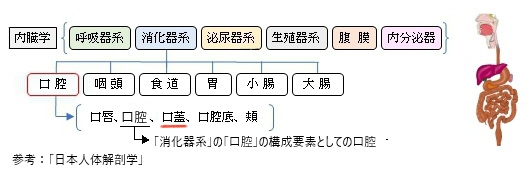【概 要】





|
|
|
|
口腔・咽頭
(縦断面) |
口腔模式図(縦断面) |
固有口腔 |
口 蓋の粘膜 |
|
|
|
|
口蓋の粘膜(模式図) |
骨口蓋 |
|
|
【神経・血管】
神 経 : 大口蓋神経 ⇒ 硬口蓋(歯肉、粘膜、腺)
鼻口蓋神経 ⇒ 硬口蓋(粘膜)
小口蓋神経 ⇒ 軟口蓋(知覚性:口蓋扁桃、口蓋帆下部、運動性:口蓋帆挙筋、口蓋垂筋)
動 脈 : 大口蓋動脈 ⇒ 硬口蓋
小口蓋動脈 ⇒ 硬口蓋
静脈 : 上記の動脈の伴行静脈(大/小口蓋静脈)と思われる。
【関連語句】
【Wikipedia】
以下は「Wikipedia」の解説文となる。
The palate (/ˈpælɪt/) is the roof of the mouth in humans and other mammals. It separates the oral cavity from the nasal cavity. A similar structure is found in crocodilians, but in most other tetrapods, the oral and nasal cavities are not truly separated. The palate is divided into two parts, the anterior, bony hard palate and the posterior, fleshy soft palate (or velum).
Structure
See also: Hard palate and Soft palate
【Innervation】
The maxillary nerve branch of the trigeminal nerve supplies sensory innervation to the palate.
Development
The hard palate forms before birth.
【語 句】
・oral cavity:口腔 ・nasal cavity:鼻腔 ・crocodilians:ワ二類 ・tetrapods:四足獣 ・hard palate:硬口蓋 ・fleshy:肉質の ・soft palate:軟口蓋 ・maxillary nerve:上学神経 ・trigeminal nerve:三叉神経 ・sensory innervation:知覚神経支配
Variation
If the fusion is incomplete, a cleft palate results.
Function in humans
When functioning in conjunction with other parts of the mouth, the palate produces certain sounds, particularly velar, palatal, palatalized, postalveolar, alveolopalatal, and uvular consonants.
History
【語 句】
・cleft palate:口蓋裂 ・velar:軟口蓋音 ・palatal:口蓋音の ・palatalize:口蓋音化する postalveolar:後部歯茎音 ・aveolapalatal:歯茎硬口蓋音 ・uvular consonants:口蓋垂音
【 イラストを掲載しているサイト 】
・ イラストや写真を掲載しているサイト-Ⅰ
・ イラストや写真を掲載しているサイト-Ⅱ
・ イラストや写真を掲載しているサイト-Ⅲ
